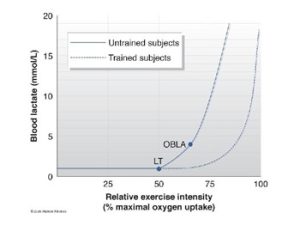Alan Jenks
Since the inception of physical contest, coaches and trainers have continually sought ways to give their athletes ‘the edge’ in performance. In modern times athletes are attaining feats of power and endurance that were once deemed impossible. So how are these mere mortals achieving superhuman outcomes? One way might be through harnessing the power of molecule called lactate.
Lactate, as we know, is often given a bad rap because for years it was considered a waste product that served little purpose aside from making your muscle sore and causing you to stop exercising. However, today lactate is looked at as an extremely useful fuel source that is constantly produced and used as a product of energy metabolism. Recall that lactate is created in the muscle and shuttled to the blood stream where it can be taken to the liver and other organs for recycling. Even at rest, the body produces lactate as our energy systems are never ‘turned off’, just upregulated or downregulated with the intensity of our movements and exercise. Resting blood lactate levels fluctuate between 0.8 and 1.5 millimoles per litre (mmol/L or mM). This is well below the level that causes any discernible impact on our body or athletic performance. However, as exercise intensity increases, the reliance on the anaerobic pathway of energy production increases, so too does the by-product of this pathway – lactate. At first, our body can ‘clear’ the increased lactate production, but prolonged high intensity exercise will eventually cause the scales to tip and blood lactate will accumulate. The amount of blood lactate has a profound impact on our ability to continue exercise at a high intensity and this holds the key for many high-level athletes. The higher one’s threshold before blood lactate begins to accumulate, generally the better athletic performance.
Lactate threshold (LT) is the highest intensity at which someone can perform aerobic exercise in a steady state without blood lactate accumulating to detrimental levels. Once an athlete passes threshold, blood lactate levels rise rapidly, and the body is unable to clear the lactate at the same rate it is produced causing lactate to accumulate in the blood and tissues (this point is referred to as the Onset of Blood Lactate Accumulation). Rising blood lactate is accompanied by a slight drop in pH (usually only from the homeostatic 7.4 to the slightly more acidic 7.2), which is thought to initiate fatigue. After threshold is crossed, an athlete can only maintain the same exercise intensity for so long before they are forced to slow down; because of this, athletes with higher thresholds can continue at a higher intensity for longer and thus LT is a good predictor of athletic performance in high intensity sports, and a metric that is often targeted for increase by trainers and coaches.
LT testing can be used to determine an appropriate training intensity and monitor progression of athletes of all levels and is often used in conjunction with VO2 max; although between the two tests, LT is the better predictor of performance.
 Lactate threshold is traditionally measured by having a person run or cycle while increasing the intensity of the exercise every 3-5 minutes until exhaustion. During these tests blood samples are collected from the fingertip or earlobe at each stage and run through a lactate analyzer which processes the blood and gives a reading of the blood lactate concentration in millimoles per litre (mmol/L).
Lactate threshold is traditionally measured by having a person run or cycle while increasing the intensity of the exercise every 3-5 minutes until exhaustion. During these tests blood samples are collected from the fingertip or earlobe at each stage and run through a lactate analyzer which processes the blood and gives a reading of the blood lactate concentration in millimoles per litre (mmol/L).
In terms of numbers, LT is described as the highest exercise intensity achieved with a less than 1.0mmol/L increase in blood lactate concentration above the pre-exercise level. Beyond LT is the Onset of Blood Lactate (OBLA). This signifies when blood lactate passes 4.0mmol/L. After OBLA is crossed, blood lactate levels can rise as high as 20.0 mmol/L!! (note: these can also be referred to as aerobic threshold and anaerobic threshold respectively).
Graphically, LT can be observed as an inflection point, or an increase in blood lactate. OBLA is seen on a graph as a second inflection point, or the point where blood lactate crosses 4.0mmol/L.

Beyond athletics, lactate testing can also be used to assess if someone is experiencing lactic acidosis, a condition caused by cells and tissues becoming hypoxic. In medicine lactic acidosis presents with symptoms like nausea, vomiting, muscle weakness, sweating, shortness of breath…the same symptoms as very high intensity exercise! For this reason, lactic acidosis has two categories: A and B. Type A can be caused by infection, shock, heart failure, liver disease or anemia, while Type B can be causes by leukemia, kidney disease, or strenuous exercise.

